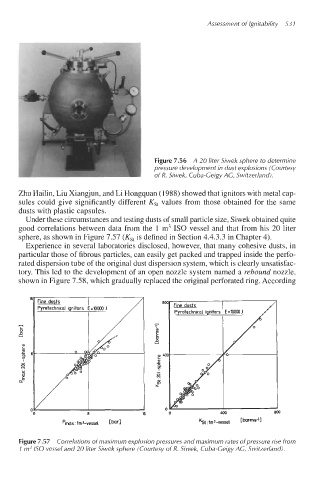Page 564 - Dust Explosions in the Process Industries
P. 564
Assessment of lgnitability 53 1
Figure 7.56 A 20 liter Siwek sphere to determine
pressure development in dust explosions (Courtesy
of R. Siwek, Cuba-Geigy AC, Switzerland).
Zhu Hailin, Liu Xiangjun, and Li Hongquan (1988) showed that ignitors with metal cap-
sules could give significantly different K,, values from those obtained for the same
dusts with plastic capsules.
Under these circumstances and testing dusts of small particle size, Siwek obtained quite
good correlations between data from the 1 m3 IS0 vessel and that from his 20 liter
sphere, as shown in Figure 7.57 (ICst is defined in Section 4.4.3.3 in Chapter 4).
Experience in several laboratories disclosed, however, that many cohesive dusts, in
particular those of fibrous particles, can easily get packed and trapped inside the perfo-
rated dispersion tube of the original dust dispersion system, which is clearly unsatisfac-
tory. This led to the development of an open nozzle system named a rebound nozzle,
shown in Figure 7.58, which gradually replaced the original perforated ring. According
Fine dusts
Pyrotechnical ignitors
if
Y
0 1
Figure 7.57 Correlations of maximum explosion pressures and maximum rates of pressure rise from
1 m3 1.50 vessel and 20 liter Siwek sphere (Courtesy of R. Siwek, Cuba-Geigy AC, Switzerland).

